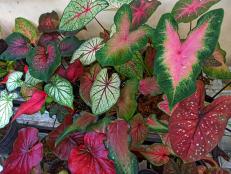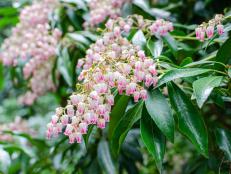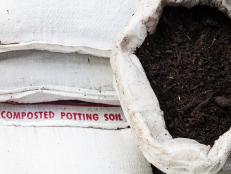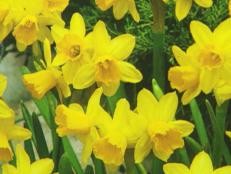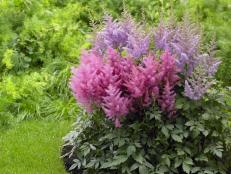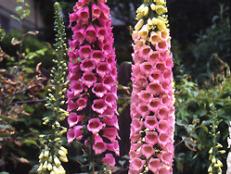Cast Iron Plant: How to Grow and Use This Houseplant and Garden Evergreen
Cast iron plants are easy to grow even if you have a brown thumb.
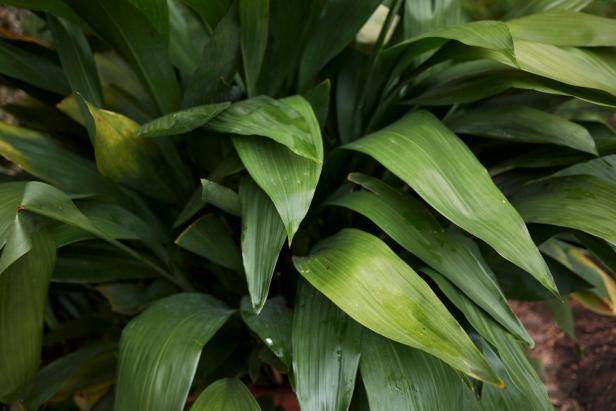
Shutterstock/simona pavan
Cast-iron plant makes a great border plant and as a ground cover, it can be easily divided.

The name says it all: cast iron plant is tough. It's a great houseplant for beginning gardeners because it practically thrives on neglect. It tolerates short periods of drought in case you forget to water it, stands up to heat, is seldom bothered by pests and diseases and grows happily in low light. They're also attractive garden plants.
Native to China and Japan, cast iron plant (Aspidistra elatior) has glossy green leaves that grow to 24 inches long. Some have cream-colored or white stripes and streaks on their foliage, while others have yellow and white speckles. Also known as bar room plants, these slow-growing members of the lily family mature at 2 to 3 feet high and 1 to 2 feet wide. Cast iron plants don't usually bloom indoors, but if they do, their small, purplish flowers open at soil level and are usually hard to see under the foliage.
Botanical Name: Aspidistra elatior
Common Name: Cast iron plant
Hardiness Zones: 7 to 11
Bloom Time: Spring
Bloom Color: Purplish
Uses: Houseplant, border plant, ground cover
How to Use Cast Iron Plant
The Victorians used cast iron plants as houseplants, and these leafy beauties are still popular choices for homes and offices. A NASA study found they can even help clean the air. Some gardeners use them outdoors as ground covers, or you can plant them at the back of shaded borders and grow smaller shade lovers like impatiens or wax begonias in front of them. Most will overwinter in USDA Gardening Zones 7 to 11, while some are hardy in Zones 7 to 10. Most outdoor cast iron plants will be damaged or die when the temperature drops below 50 degrees.
Forgiving Houseplants 21 Photos
Cast-iron plant is among these plants perfect for indoor gardeners with brown thumbs.
While Aspidistra flowers aren't anything special — they're considered insignificant — you can cut the plants' lance-shaped leaves to add structure and interest to flower arrangements.
How to Grow Cast-Iron Plant
Light Needs
Cast iron plant care is easy. These plants thrive in low light, so give them a dim corner or north-facing window. Outdoors, grow them in a shaded spot with indirect or dappled light. Avoid direct sunlight, which can burn the leaves and bleach their color.
Soil Requirements
Nearly indestructible cast iron plants adapt to most kinds of soil, as long as it drains easily. To enjoy them indoors, use containers with drainage holes and good-quality potting soil. In the garden, they prefer organically rich soil but will grow in well-draining sandy, clay or loamy soils with a slightly acidic to neutral pH.
How to Water
While cast iron plants can tolerate some drought, they do best in slightly moist soil. Water them regularly during the first growing season, letting the top few inches of soil dry out before you water them again. Don't let them sit in saucers or trays of excess water or in soggy garden soil, which can lead to root rot.
Fertilizer Needs
For indoor cast iron plant care, use a liquid houseplant fertilizer during the spring and summer in the amount shown on the product label. Feed outdoor plants with an all-purpose fertilizer once a year in the spring or summer. Stop fertilizing in the fall and winter. If the leaf tips turn brown, you may have overfertilized.
Temperature and Humidity
Avoid temperature extremes with cast iron plants. They grow best over 50 degrees and up to 85 degrees. In nature, cast iron plants grow on the rainforest floor, but while they like moist air, they can handle average home humidity.
Pests, Diseases and Other Problems
These low-maintenance plants don't usually suffer from pests or diseases if they have the right outdoor growing conditions, but sometimes scale, spider mites and mealy bugs can attack them indoors. Knock off the pests with a spray of lukewarm water from the shower or kitchen sink. If they come back or you have a heavy infestation, treat your plants with horticultural oil or insecticidal soap and follow the label directions.
Brown tips on Aspidistra leaves can be a sign of too much or too little water. Be sure you're letting the soil dry a few inches deep between waterings.
Leaves that turn brown or look bleached may be getting too much sunlight. Drafts can also cause browning, so keep your plant away from vents and windows and doors that let air leak in. Variegated plants that lose their variegation usually need more light.
If your plant's leaves get dusty, wipe them off with a damp cloth.
Cast Iron Plant Care: Pruning
Cast iron plants don't need much pruning but remove any leaves that turn yellow or dry and brown. If you live where cast iron plants can grow outdoors, as perennials, control their size by pruning them at the base when needed.
Cast Iron Plant Care: Propagating
It's easy to propagate Aspidistra elatior by division. Take your plant out of its container or dig it up from your garden. Cast iron plants have rhizomes, or underground stems that grow horizontally and produce roots and shoots so new plants can grow.
Cut off a rhizome with two or three leaves, replant it in the ground or in a container with drainage holes and water it. If you're dividing a large plant, you can cut more rhizomes.
Types of Cast Iron Plants to Grow
'Lennon's Song' (Aspidistra elatoir) — Gardeners grow this cast iron plant for its narrow, dark green leaves with irregular stripes of creamy yellow. Hardy in Zones 7 to 10.
'Alishan Giant Splatter' (Aspidistra attenuata) — This attractive plant has green leaves with golden speckles. Hardy in Zones 8 to 11, it can reach 38 inches tall.
'Hoshi-zora' (Aspidistra elatior) — Light yellowish-white speckles earn this old cultivar its Japanese name, which translates to starry skies. Hardy in Zones 7 to 10, it matures at 30 inches tall.
'Goldfeather' (Aspidistra elatior) — Relatively fast-growing 'Goldfeather' reaches 30 inches tall and overwinters in Zones 7 to 10. Its green leaves are streaked with yellow-green.
'Snow Cap' (Aspidistra elatior) — The leaves on this Japanese selection are tipped with white. At 30 inches tall, the plants brighten shady garden spots in Zones 7 to 10.
'Okame' (Aspidistra elatior) — White stripes highlight this plant's dark green leaves. Hardy in Zones 7 to 10, it reaches 30 inches tall.
Companion Plants for Cast Iron
These perennials thrive outdoors in shady spots, so they're great to grow as companions for cast iron plants in the garden.
- Ferns
- Trillium, also called toadshade
- Columbine
- Flax lily
- Foam flower
- Jack in the Pulpit (Arisaema)
- Lenten Rose (Helleborus)
- Solomon's Seal (Polygonatum)







